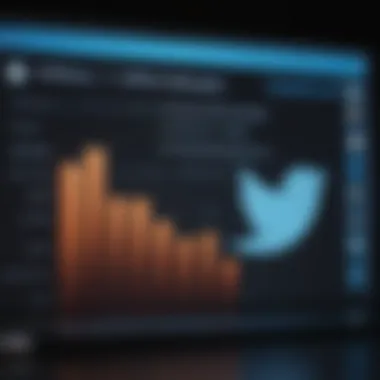Examining Twitter Stock Potential: Key Insights and Future Trends


Intro
The world of investing can sometimes feel as thrilling—and perilous—as walking a tightrope. When it comes to Twitter stock, the stakes can seem higher given its dynamic market presence and ever-evolving social media landscape. Investors, whether seasoned or just stepping into the fray, have a vested interest in understanding Twitter's potential, especially as it weaves its way through challenges and opportunities alike.
In this analysis, we’ll take a comprehensive plunge into Twitter’s financial metrics, scrutinize industry trends, and evaluate how competitive pressures shape its stock performance. The landscape of social media is so rapid-fire that even a minor news bite or algorithm tweak can send stocks flying or nosediving. Therefore, gathering insights is not merely beneficial; it’s essential.
We'll also shine a light on key performance indicators—those numbers that tell a story about future earnings potential, user growth, and overall market health. Coupled with external economic conditions, these indicators will assist investors in crafting a picture of what lies ahead for Twitter's stock.
Thorough understanding can empower investors, helping them navigate not just the opportunities but also the pitfalls. In the grand tapestry of finance, sometimes it’s the threads of intricate detail that weave together the most compelling narratives, showing the potential of Twitter through myriad lenses. Let’s unravel the layers, starting with the core concepts that underpin our analysis.
Foreword to Twitter Stock Dynamics
In the world of investing, understanding the dynamics of stocks is essential. This is particularly true for social media companies, where rapid changes can significantly affect stock performance. Twitter, being a key player in this domain, presents a fascinating case for observation and analysis. The nuances of Twitter’s stock dynamics can often be overlooked amidst the noise of everyday trading, yet they hold essential clues about potential future shifts in performance.
In this section, we will explore the factors that contribute to the movements in Twitter’s stock price. By dissecting elements like market sentiment, user engagement, and revenue streams, investors can gain deeper insights into what drives Twitter’s stock. The volatility associated with social media stocks requires a keen eye and an understanding of various external and internal factors that influence trading behaviors.
Overview of Stock Performance Trajectory
Twitter's stock has witnessed its fair share of ups and downs. Analyzing its trajectory can help identify patterns and predict future behavior. For instance, significant news stories, changes in management, or quarterly earnings reports can cause stock prices to swing dramatically.
To grasp the broader performance context, consider the following:
- Initial Public Offering: After its public offering in 2013, Twitter's stock surged, fueled by excitement and promising user growth.
- Periodic Highs and Lows: Over the years, various factors led to peaks, such as new product launches, and troughs due to controversies or changes in user engagement metrics.
- Current Trends: Recently, the focus might be shifting toward how Twitter adapts to competition and evolving user behaviors, which could set the stage for its next period of growth.
In sum, keeping a close eye on the stock performance trajectory is imperative for making sound investment choices.
Importance of Analyzing Social Media Stocks
Social media companies, like Twitter, are often viewed through a unique lens. Their business models, user engagement, and market influence differ considerably from traditional corporations. Hence, investors must approach them with a specific analytical mindset.
Understanding the importance of analyzing social media stocks includes:
- Engagement Metrics: Unlike other industries, user engagement is a key metric. It directly correlates with advertising revenues, making it crucial for assessing a company’s health.
- Market Sentiment: Social sentiment can drive stock prices. Public perception, influenced by events such as policy changes or user dissatisfaction, can lead to significant market fluctuations.
- Brand Influence: Social media platforms play a huge role in shaping popular culture. Their influence impacts many businesses, which in turn affects their stock prices.
The social media industry's atmospheric changes require investors to remain vigilant and adaptable. Understanding these patterns assists in navigating the often unpredictable waters of stock investments.
Twitter’s Business Model Examination
Understanding Twitter’s business model is pivotal when evaluating its stock. This dynamic platform operates in a landscape that is not just about tweets but is also deeply intertwined with how it generates revenue and maintains user engagement. The nuances of its various revenue streams and the significance of user-related metrics provide a clearer understanding of its potential trajectory in the stock market.
Revenue Streams: Advertising, Subscriptions, and More
When it comes to revenue, Twitter primarily focuses on advertising, which accounts for a substantial portion of its income. This encompasses various formats such as promoted tweets, trends, and accounts. Businesses engage with users in real time, harnessing Twitter's vast user base for targeted campaigns.
- Advertising Revenue: Approximately 85% of Twitter's revenue comes from advertising. As more brands recognize the importance of a social media presence, competition for ads increases. The conversion rates can vary, but advertisers often see strong returns when campaigns resonate with users. This leads brands to invest heavily in creative advertisements that engage potential customers.
- Subscriptions: Besides advertising, Twitter has explored additional revenue avenues, such as subscriptions. The introduction of Twitter Blue allows users to pay for premium features, including an edit button and custom app icons. Although still a smaller segment of their overall revenue, this could potentially grow as users look for enhanced tweeting experiences.
- Data Licensing: Another lesser-known revenue stream is the licensing of Twitter data to third parties. This area can be lucrative as companies seek insights from Twitter’s vast troves of user-generated content. They can use this data for market research, trend analysis, and more.
Each revenue stream has its own set of benefits and risks. For instance, advertising revenue is susceptible to economic downturns, which may prompt advertisers to cut back. However, the diversification into subscriptions and data licensing provides a cushion against fluctuations in ad spending.
User Engagement Metrics and Their Significance
User engagement metrics serve as the heartbeat of Twitter’s identity, affecting both its business model and stock performance. High engagement indicates that users find value in the platform, which can translate into increased advertising revenue due to extended reach and frequency of impressions.
- Active Users: Monitoring metrics like Daily Active Users (DAU) and Monthly Active Users (MAU) helps investors gauge Twitter's popularity. A growing number of active users typically signifies a healthy platform.
- Engagement Rates: Look beyond simple user counts to metrics such as retweets, likes, and comments. These actions indicate how compelling content is, crucial for advertisers looking for effective placements.
- User Growth and Retention: Not only is acquiring new users important, but retaining them is crucial too. Strategies that enhance the user experience—such as personalized feeds and better curation—can significantly affect retention rates.
"Engagement is not merely about numbers; it's about creating a vibrant community that wants to come back for more."
Investors should also be aware that fluctuations in user engagement can greatly influence Twitter's stock price. If engagement starts to decline, it may trigger a warning sign, leading to potential stock sell-offs.
By understanding Twitter's revenue streams and user engagement metrics, investors can make more nuanced decisions regarding their investing strategies. These elements not only affect Twitter's immediate financials but also shape its long-term growth trajectory in the competitive social media landscape.
Market Trends Impacting Twitter
Understanding market trends is pivotal when analyzing Twitter's stock. This aspect provides valuable insights into how both external and internal forces shape the company's trajectory. In this section, we'll dissect both broader shifts in social media and the challenges posed by competitors. By doing this, we shine a light on the opportunities and threats that investors should keep in mind.
Broad Social Media Landscape Analysis


The social media landscape is a dynamic and ever-changing environment. For example, platforms like Instagram, TikTok, and Snapchat have steadily gained traction, pulling users away from Twitter. It's essential to grasp how these shifts affect user engagement on Twitter. As people flock to visually engaging platforms, Twitter's traditional strength in real-time updates faces significant pressure.
Key points about this landscape include:
- User Preferences: Many users, especially younger demographics, now prefer video content over text updates. This shift necessitates Twitter to rethink its strategic approach and possibly enhance their multimedia sharing capabilities.
- Advertising Dynamics: Advertisers chase where the audience goes. If Twitter fails to keep its user base engaged, it might experience a decline in advertising revenues compared to its rivals.
- Evolving Algorithms: Social media platforms are continuously tweaking their algorithms to optimize user experience. Clinging too tightly to a legacy model can hinder Twitter’s adaptability, making it less appealing for both users and advertisers.
The competition is heating up, and Twitter must be agile in responding to users' changing preferences to maintain its standing.
Competitive Analysis: Key Players and Challenges
Diving deeper into the competitive arena, we can't overlook the pressure from giants like Facebook and TikTok. Each platform brings unique attributes that pose a challenge for Twitter’s growth. For instance, TikTok's algorithm fosters viral trends through immersive content, making it hard for Twitter to retain its audience’s attention.
Consider the following challenges Twitter faces compared to its competitors:
- Feature Limitations: Unlike Facebook’s vast range of features—from stories to groups—Twitter largely relies on its traditional tweet model. This limitation might alienate users seeking more versatile platforms.
- Market Strategies: Rival companies continue to push boundaries with innovative strategies. For instance, Facebook's aggressive move into e-commerce has captured significant user interest, presenting a strong distraction for potential Twitter users.
- Regulatory Scrutiny: All major social media platforms are under the watchful eye of authorities. However, Twitter’s unique challenges include maintaining balance in free speech while tackling misinformation effectively, something that is not as pronounced for others.
"Navigating through competitive waters requires more than just awareness of rivals; it demands strategic foresight to innovate and adapt."
This competitive pressure forces Twitter to quickly evaluate its position and make necessary adjustments to avoid being sidelined in the increasingly crowded social media arena.
By understanding these dynamics, investors can better gauge the stock's potential and the shifts that could affect its value in the market.
Key Performance Indicators to Consider
When it comes to making informed decisions about Twitter's stock, Key Performance Indicators (KPIs) play a pivotal role. KPIs are like the compass guiding investors through the tumultuous waters of financial markets. Analyzing KPIs helps in assessing the health of a company, revealing insights into both its current performance and potential future trajectory. In the case of Twitter, understanding these indicators is essential for investors to grasp the full picture, particularly given the complexity and competition within the social media landscape.
Earnings Reports: What They Reveal
Earnings reports are often the crucial lifeblood for investors looking to understand a company's financial health. For Twitter, these quarterly reports shed light on various aspects of its operations. They provide valuable insights into revenue trends, net income, and earnings per share, which are critical metrics for gauging profitability. An upward trajectory in these metrics can signal strong demand for the platform, whereas a downturn might raise red flags.
Moreover, earnings reports often include disclosures regarding user growth and engagement rates, which are vitally linked to revenue generation via advertising. For instance, if a report shows a dip in user engagement but a rise in ad revenue, it may indicate that existing users are generating more value, but the challenge remains on attracting new users. Thus, investors should examine these reports closely, dissecting not only the numbers but also the context surrounding them.
User Growth Rates and Retention Patterns
The measure of how well twitter retains and grows its user base is another vital KPI. High user growth rates can signify that the platform is attracting new users successfully, while retention patterns indicate whether users find the platform valuable enough to return. It's essential to focus on the balance of these two metrics; high churn rates can counteract growth if existing users are not sticking around.
When analyzing user growth, one should look beyond surface numbers. For example, the demographic breakdown—whether the platform is appealing mostly to younger or older audiences—affects long-term monetization strategies. Understanding who uses Twitter and how often they engage with content can provide an edge in predicting future revenue streams.
Profit Margins and Financial Health
Finally, profit margins present a significant picture of Twitter's financial health. They reveal how efficiently Twitter turns its revenues into profit, which can significantly affect investor sentiment. A higher profit margin indicates that a company has better control over its costs, which is crucial for survival in a competitive industry where profit can be tight.
Apart from margins, evaluating overall financial health through metrics like debt levels and cash flow is crucial. These factors tell a more comprehensive story about Twitter's ability to invest in growth, pay dividends, or weather financial storms. Analyzing these KPIs in tandem allows investors to assess not only where the company stands today but also where it might head in the future.
"Understanding key performance indicators is like possessing a map for intricate terrain; without them, it's easy to get lost in the maze of investment decisions."\n By keeping these Key Performance Indicators at the forefront of investment strategies, investors can form a clearer perspective on Twitter's stock potential, ensuring they traverse the financial landscape with greater confidence.
External Economic Factors
When it comes to investing in stocks, especially in a tech-oriented space like social media, external economic factors play a crucial role. These elements can shift the landscape quickly, affecting investor confidence and stock performance in unpredictable ways. Understanding them is not just useful; it can be vital. This section will delve into the broader economic environment and the regulatory issues impacting Twitter, offering insights into how these factors intertwine with the company's stock potential.
Impact of Global Economic Conditions
Global economic conditions can send ripples through the stock market, often influencing stock prices before analysts even have a chance to digest the data. Factors such as inflation rates, interest rates, and geopolitical tensions determine how favorable or unfavorable the market can be. For example, if the economy is booming, consumer spending generally rises, boosting advertising revenues — a primary revenue stream for Twitter.
Conversely, in a recession, companies often tighten their advertising budgets. As social media companies heavily rely on ad revenue, any downturn can hit hard. The fluctuations in global currencies and trade policies also affect how companies operate internationally and share their profits.
Imagine if a major recession hits the Eurozone — that would lead to a decline in ad spending across the board. If Twitter’s European user base accounts for a noticeable percentage of revenue, the stock value may take a nosedive.
Thus, investors should always keep their eyes peeled on global trends. Understanding economic indicators can provide early warnings about what’s coming next for Twitter’s stock, enabling investors to adjust strategies accordingly.
Regulatory Challenges and Opportunities
Regulation in the tech and social media sector remains a double-edged sword. On one hand, stringent regulations may hamper growth or introduce compliance costs, making investors wary. On the other hand, a framework that offers fairness and privacy protections can enhance user trust and bring about stability. So where does Twitter stand amidst it all?
Recently, there has been a surge in scrutiny toward social media platforms. Governments around the world are pushing for better data protection and transparency. Twitter is no stranger to controversies regarding privacy. For instance, past data breaches and regulatory fines could resurface if the platform doesn't uphold stringent privacy standards.
But there’s more to it than just potential pitfalls. By proactively embracing regulations, Twitter could potentially improve its standing. If it positions itself as a champion of user privacy, it may attract more users — which translates to substantial long-term financial gains.


To summarize:
- Regulatory changes can both present challenges and offer opportunities.
- Proactive adaptation to legislation can enhance consumer trust and loyalty.
- A robust compliance framework might shield Twitter from significant legal costs down the line.
As the saying goes, "What doesn't kill you makes you stronger." In the fast-paced tech industry, adaptability is essential. If Twitter successfully navigates regulatory waters, its resilience could pay off in the long run, significantly impacting its stock valuation.
Investor Sentiment and Market Perception
Understanding investor sentiment and market perception is crucial to assessing Twitter's stock. They play a pivotal role in shaping stock prices, particularly in a sector as volatile as social media. Investors react not just to financial reports but also to market trends, news, and community opinions, which creates a complex web of influences on investment decisions.
When investors express optimism or pessimism about a stock, it sometimes diverges from the underlying fundamentals. For instance, if Twitter announces a new feature yet the sentiment remains negative due to external factors like regulatory scrutiny, the stock could suffer despite potential improvements.
Understanding Market Psychology
Market psychology revolves around how emotions and perceptions influence traders' behaviors. In many ways, it acts like a barometer of collective behavior. FOMO (fear of missing out) can drive prices up when excitement surrounds a company, while FUD (fear, uncertainty, doubt) may lead to panic selling.
Factors to consider include:
- Social Media Feedback: Twitter thrives on real-time feedback. Public sentiment steers discussions; trending hashtags can entirely shift perceptions, thus impacting share prices.
- News Cycles: Major headlines or events can incite swift market responses. For instance, a cyber security breach might provoke immediate selling, regardless of the company's long-term viability.
- Analyst Ratings: Analyst reports can significantly sway investor sentiment. A positive change in rating could prompt buying, while a downgrade might lead to a sell-off.
Social Media Influence on Stock Prices
The intersection of social media and stock prices is particularly pronounced with Twitter itself. The platform serves as both a communication tool and a marketplace of ideas. This duality allows for instant dissemination of opinions, which can lead to rapid stock price fluctuations.
Consider the following aspects:
- Influencers and Celebrities: When high-profile figures tweet about their investments or opinions on Twitter, it can instigate significant market movements. Take Elon Musk’s tweets, which have historically moved not just Twitter's stock but others too.
- User Behavior: The number of active users and their engagement metrics can reflect investor sentiment directly. A drop in user growth may indicate future challenges, impacting the stock price negatively.
- Viral Trends: A viral tweet can cause sudden shifts in perception. A humorous or relatable tweet about the platform itself might enhance its appeal, translating directly into a favorable market outlook.
Investor sentiment can often swing like a pendulum, driven by news and social media chatter, making it essential to maintain a pulse on digital conversations when investing in Twitter's stock.
In essence, understanding investor sentiment and market perception allows for a more profound analysis of Twitter stock potential. This insight can guide investment decisions more accurately than looking at numbers alone, blending analytics with the art of interpreting human behavior.
Culmination
In summary, investor sentiment and market perception weave a rich tapestry that influences Twitter's stock. Analyzing how emotions and social media interplay offers a nuanced understanding of market movements, essential for making informed investment choices.
Comparison with Other Stocks
When looking at Twitter's stock potential, positioning it against competitors allows investors to understand its relative efficiency and growth trajectory. Comparison with other stocks in the tech and social media sectors highlights not just performance metrics but also broader market trends and investor sentiment. Analyzing Twitter alongside major players provides a nuanced view into how it stacks up in terms of valuation, growth prospects, and user engagement. This way, investors can make more informed decisions based on comparative analysis rather than viewing Twitter in isolation.
Benchmarking Against Major Competitors
To effectively benchmark Twitter, it’s crucial to consider direct competitors like Facebook, Snapchat, and LinkedIn. Each of these platforms not only competes for advertising dollars but also seeks to engage users in unique ways. When assessing Twitter, look at its user base growth, engagement rates, and other performance indicators, and compare these with those from, say, Meta Platforms, which owns Facebook and Instagram. Meta's extensive user data and monetization strategies often outperform, therefore creating a real challenge for Twitter.
Furthermore, Twitter's move towards subscription services, like Twitter Blue, attempts to diversify revenue streams similar to strategies seen at platforms like LinkedIn, which leverages premium memberships. So, it's important not just to look at surface figures or market caps but to evaluate how operational strategies differ. Here’s a basic comparison using key metrics:
- User Growth Rate: Twitter’s growth remains steady but significantly trails behind Facebook’s rapid expansion.
- Engagement Metrics: Engagement on Twitter is typically higher on a per-user basis compared to Instagram and Facebook, making it a prime spot for real-time conversations.
- Revenue Streams: When considering advertising revenue, Facebook still dominates with approximately 90% of its total revenue from ads, while Twitter is making efforts to generate more through subscriptions.
Sector Performance Ratios
Examining key sector performance ratios is an indispensable part to measure how Twitter performs in the social media sector. Ratios like P/E, price/sales, and debt/equity provide investors with insight into valuation and risk exposure.
- Price-to-Earnings (P/E) Ratio: Twitter’s P/E ratio is generally higher than some established players, indicating that investors might expect more growth despite its recent struggles in ad revenue.
- Price-to-Sales (P/S) Ratio: This indicates how much investors are willing to pay for each dollar of sales. A lower P/S ratio suggests undervaluation, a perspective that could spark interest from value-oriented investors.
- Debt-to-Equity Ratio: Measuring the extent to which Twitter is financing itself through debt compared to equity. High ratios in this regard could signal financial risk.
The beauty of these ratios is not just in their individual figures but in the story they tell when compared against industry standards. Such metrics can assist in evaluating investment viability, and they'll play a key role in understanding not just Twitter's current position, but predicting its future.”
"It’s through comparative understanding that one can perceive the nuances of Twitter’s potential—diving into the specifics can illuminate hidden opportunities and risks."
Keeping these comparative insights in mind arms investors with the knowledge to navigate their options more effectively. Being informed about sector opportunities and threats solidifies the foundation for sound investment decisions.
Advanced Analytics and Forecasting
Analyzing Twitter's stock potential cannot be complete without delving into advanced analytics and forecasting. These tools are indispensable for investors who seek not just the surface-level numbers but a deeper understanding of trends, patterns, and potential outcomes that can influence their decisions. Embracing advanced analytics allows investors to harness data in a way akin to wielding a compass through unpredictable market waters.
Evaluation of Technical Indicators


Technical indicators serve as the backbone of forecasting for stocks like Twitter. They allow investors to distill vast troves of data into manageable insights. Common indicators include moving averages, relative strength index (RSI), and Bollinger Bands, among others. Each of these offers a lens through which to view Twitter's stock behavior.
- Moving Averages: This indicator smoothens out price data to identify trends over a specific period. For example, if the 50-day moving average crosses above the 200-day average, it’s often viewed as a bullish signal.
- Relative Strength Index (RSI): RSI measures the speed and change of price movements, typically ranging from 0 to 100. A reading above 70 indicates overbought conditions, while below 30 suggests oversold.
- Bollinger Bands: This tool uses a moving average and standard deviations to create bands that can signal price volatility. If Twitter's stock approaches the upper band, it might be a cue to sell, while nearing the lower band could signal a buying opportunity.
Using these indicators helps in recognizing potential entry and exit points. However, one must remember they shouldn’t be used in isolation; a broader analysis incorporating fundamentals must also be considered.
Long-term Projections and Models
Long-term projections are the Holy Grail for many investors peeking into Twitter’s future. These models take into account not only historical performance but also factors like user growth, engagement metrics, and broader economic conditions.
When forming long-term projections, here are a few aspects that often get consideration:
- User Growth Trends: Scrutinizing how Twitter adds and retains users can provide insights into its stability and potential future revenue streams. A plateau in user growth might spark concerns about the stock’s upward potential.
- Changes in Revenue Streams: Like the transition from traditional advertising to subscription services, the outlook can significantly change based on how Twitter evolves its business model.
- Macroeconomic Factors: Economic conditions like inflation and global trade can impact advertising budgets, directly affecting Twitter’s revenue.
Ultimately, crafting these projections relies not just on quantitative data but also qualitative interpretations of market sentiment, emerging technologies, and regulatory changes that could influence Twitter's operations.
"In the world of investing, it's not about how much you invest, but how well you understand the factors influencing that investment's potential."
By meticulously evaluating both technical indicators and long-term projections, investors can create a clearer picture of Twitter's future potential, enabling more informed, strategic decisions.
Risks Associated with Investing in Twitter Stock
When it comes to any investment, particularly in a company like Twitter, assessing risks is not just prudent; it’s essential. Twitter stock, while full of potential, is equally fraught with uncertainties that investors must carefully consider. In this section, we will dive into some of the critical risks associated with investing in Twitter stock, ensuring that both seasoned and new investors are aware of the landscape of challenges that may lie ahead.
Market Volatility Considerations
Market volatility can send ripples through even the sturdiest of investments. Twitter, like many tech-based companies, often finds its stock price swaying with the winds of market sentiment. This volatility can stem from various sources:
- Economic Changes: Unexpected shifts in macroeconomic indicators, such as interest rates or inflation, can lead to rapid changes in market behavior. Investors might start second-guessing the viability of certain tech stocks, resulting in a sell-off.
- Earnings Reports: The reaction to earnings releases can lead to immense fluctuations in stock prices. A beating or missing of expectations often results in dramatic shifts in investor sentiment, leaving some investors in the dust if they’re not quick on their feet.
- Social Media Trends: As a social media platform, Twitter's own user trends can heavily influence its stock. A trending issue that adversely affects user engagement might send the stock tumbling. Thus, understanding social cues and patterns becomes imperative for investors.
Ultimately, the key to navigating these waters is to stay informed. Keep your ear to the ground regarding market news and trends that may signal significant changes in Twitter's trading environment.
Technological Disruptions and Their Outcomes
Tech companies stand on a tightrope, always at risk of disruption from new technologies or innovative competitors. Twitter is not an exception and must continuously adapt to stay relevant. Here are a few factors that may impact its technological landscape:
- Emerging Platforms: New social media platforms can emerge seemingly overnight. If these competitors resonate with users more effectively than Twitter, it could lead to a decline in user engagement, which is critical to its advertising revenue streams.
- Shifts in User Behavior: The preferences of users can shift rapidly, often driven by trends in technology such as mobile apps or changes in consumer habits, leading to decreased usage of Twitter if it fails to innovate or meet those needs.
- Regulatory Changes: With increasing scrutiny on tech companies, any sudden regulatory shift can pose serious challenges. Compliance with new laws or guidelines could require time and resources that distract from Twitter's core business activities.
"Understanding the potential for technological disruption is almost like reading a crystal ball; it can provide insight into future stock behavior if you know what signs to look for."
Investors must remain vigilant, not only by keeping abreast of existing competition but also by considering the ripple effects that new technologies could have on the market and on Twitter itself. A proactive approach to adaptation can mitigate some risks associated with technological change.
Navigating the risks involved with Twitter stock is a task that requires vigilance, awareness, and sometimes, a little foresight. As market conditions, technology, and user preferences change, so too must strategies for investment. Staying informed not just about Twitter but the surrounding ecosystem will better equip investors to make sound decisions.
Culmination: Assessing Twitter's Future as an Investment
Wrapping up our exploration of Twitter as an investment, it’s pivotal to understand the dynamics that make or break a company in this fast-paced, ever-evolving market. The importance of evaluating Twitter's stock can’t be overstated. The platform's unique position in the social media landscape, its diversified revenue streams, and the various external economic factors contribute significantly to its potential for growth and opportunity.
Investors need to consider several vital elements when looking at Twitter's future:
- User Engagement: The very fabric of social media is user engagement. Twitter's ability to keep users active directly influences its advertising revenue, which is a huge boons for potential profits.
- Competition: With giants like Facebook and emerging platforms continuously vying for user attention, understanding Twitter's competition can shed light on its sustainability and growth prospects.
- Economic Landscape: External economic factors, including regulatory challenges and general economic conditions, can create hurdles that may affect stock performance. Keeping an eye on these aspects is crucial for sound investment decisions.
This conclusion aims to encapsulate the essence of this analysis, guiding investors towards a well-informed stance regarding Twitter’s investment viability.
Summary of Key Insights
Here’s a recap of the major points discussed:
- Twitter's Business Model:
- Market Trends:
- Performance Indicators:
- Revenue generation through advertisements and subscription models.
- Importance of user engagement metrics.
- The competitive landscape reveals challenges as well as opportunities for growth.
- External factors such as economy and regulatory frameworks play a dual role in both risk and reward potential.
- Earnings reports provide clarity on financial health, while user growth rates highlight the platform’s sustainability.
- Profit margins will impact overall investment decision-making down the line.
Identifying these insights empowers investors to understand where Twitter stands in the market hierarchy. It also brings clarity to their future prospects and aids in assessing the risk versus reward ratio involved in investing in Twitter's stock.
Final Thoughts on Investment Viability
Deciding whether to invest in Twitter is no easy feat. The landscape is dotted with complexities that require astute analysis and keen foresight. As concluding thoughts, it’s imperative to reflect on the essential points that weigh into Twitter's viability as a worthy investment:
- Resilience and Adaptability: The platform must consistently adapt to user behavior changes and market demands. Investments flourish in environments that are flexible and responsive to shifts.
- Continued Innovation: Platforms like Twitter often succeed or fail based on their innovative capabilities. New features and user engagement strategies should be part of their long-term plan.
- Market Sentiment: Emotional expressions within the market can sway stock prices dramatically, making an understanding of market psychology key to maintaining investment health.















